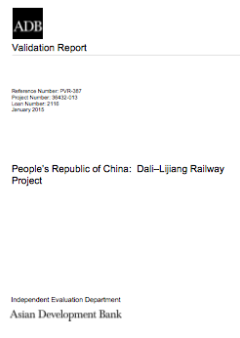
People's Republic of China: Dali-Lijiang Railway Project (Validation Report)
At the end of 2003, the PRC railway system already comprised a total of 73,000 routes per km. However, the railways' capacity had failed to keep up with the demand, resulting, for example, in delays in coal delivery to power plants. These capacity limitations, could adversely affect economic growth.
Partly due to inadequate transport, the largely mountainous project area had not been integrated into the economic mainstream. The then existing class II roads had to pass through difficult terrains, had limited passing capacity, and were affected by rain. Despite abundant natural resources, many people in the area were poor, with most working in the agriculture sector. In the mountainous areas, people supplement their incomes by engaging in animal husbandry or becoming migrant laborers. Economic growth has not improved partly due to inadequate transport services and high transport costs. Local governments and people in the project area expected the railway investment to address the problems of slow economic development and poverty.
The railway link was to allow connectivity from northwestern Yunnan province to Kunming, Shanghai, and Beijing via three of the 16 east–west and north–south national rail corridors. The project was to provide accessibility to Fangcheng and Beihai ports and promote regional cooperation in the Greater Mekong Subregion (GMS) through Yunnan province, which has borders with other GMS countries. Through the rail network, the project area would be linked to Haiphong port in Viet Nam and the Pan-Asian railway. The project and associated developments could stimulate industrial and natural resource development, tourism, and related industries; generate employment; increase living standards; and help reduce poverty.
This report validates the completion report's assessment of the project. IED overall assessment: Successful.
